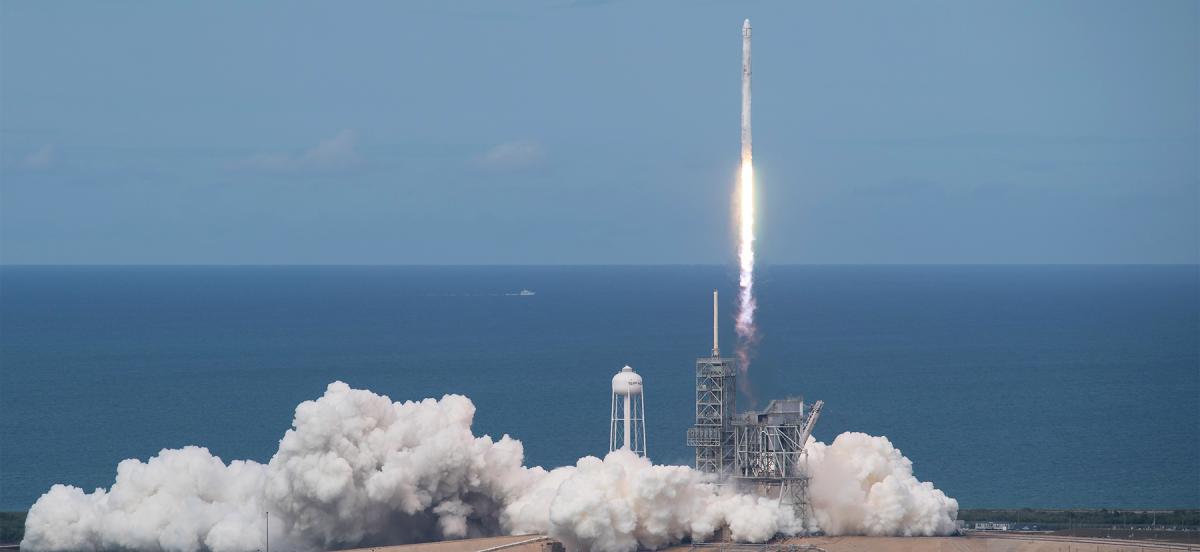New Haverford Professor Launches Experiment on Rocket to International Space Station

The SpaceX Falcon 9 rocket launching from NASA’s Kennedy Space Center in Cape Canaveral, Florida, Saturday, June 3, with Professor Andrea Lommen’s NICER telescope on board. Photo by NASA/Bill Ingalls.
Details
Andrea Lommen, the latest addition to the Department of Physics and Astronomy, is part of a team whose x-ray telescope study is aboard the SpaceX Falcon 9 mission.
When the SpaceX Falcon 9 rocket launched from NASA's Kennedy Space Station in Cape Canaveral, Fl., on June 3, there was a Haverford connection onboard. An x-ray telescope, known as NICER (Neutron star Interior Composition Explorer) was on the flight and set to be installed at the International Space Station for a year and a half thanks to a team that includes Andrea Lommen, the College's newest professor of physics and astronomy.
In her research, Lommen, who, for the past 14 years, has taught at Franklin and Marshall College in Lancaster, Pa., looks for wrinkles in space time, called gravitational waves, using pulsars. With NICER, she will be able to study the x-ray beacons emitted by these pulsars, testing, for the first time in space, technology that uses pulsars as navigation beacons.
"There are thousands of pulsars distributed around the galaxy, like a celestial system of clocks," said Lommen. "So if you want to detect ripples in time, what better way than by a system of clocks donated to you by the universe? That's what we do. We time the arrivals of the pulses from the pulsars, and look for deviations in their arrival time. Any deviation that is coordinated among the pulsars we see may be a gravitational wave. … [With NICER] we will learn an enormous amount about pulsars themselves, and it will also tell us a great deal about what we need to do to make our gravitational wave experiment successful."
Though she didn't have a technical role in the launch, Lommen traveled with one of her children, Rose, and her father to Florida to observe the rocket carrying NICER as it was blasted into space.
"I suppose my most important role was that of letting my daughters grow up with the idea that putting experiments on rockets and plugging them into the space station is a totally normal thing to hope for," she said.
Lommen, herself, has long been on a path to sending experiments into space. (This NICER launch is, in fact, the second such project her team proposed to NASA; the first one was back in 2007.) She grew up in Santa Barbara, Calif., the daughter of two scientists, and was fascinated from an early age by astronomy.
"I watched a lot of Star Trek and really believed it when they said that space is the final frontier," she said.
After earning her B.A. in physics from Carleton College, she completed two master's degrees—an M.S. in physics and the University of Pennsylvania and an M.A. in astronomy at the University of California, Berkeley—before earning her Ph.D. at Berkeley. After a postdoctoral year at the Anton Pannekoek Institute in Amsterdam, she joined the faculty at F&M in 2003. And now she is excited to be starting her appointment at Haverford on July 1.
"I resonate deeply with Haverford's commitment to undergraduate research, and I really appreciate the resources they provide for making that possible," she said. "I wouldn't be doing what I'm doing today if one of my college professors, Joel Weisberg, hadn't suggested I work on a research project with him."
The SpaceX shuttle, which was contracted by NASA to resupply the International Space Station, will take several days to reach its destination, and Lommen says that the maneuver to install it will take an additional few days. She expects to be receiving data by the end of the month and plans to use her Haverford students to analyze the reams of information that will be transmitted back.
"The mission is 18-months long," she said, "and we expect to be receiving data daily for that whole time, perhaps longer."
So students in her lab can plan to be quite busy.
-Rebecca Raber



